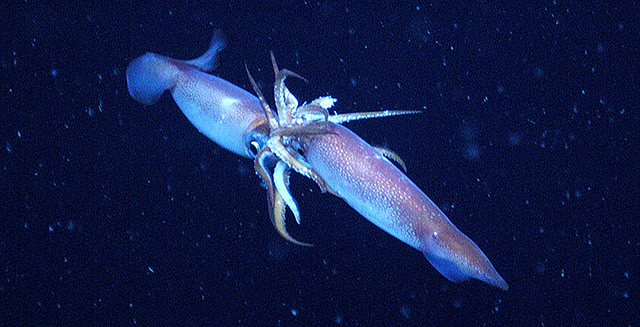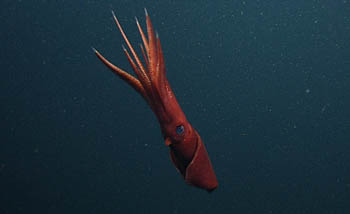Maximum Size
17 cm
(7 inches) mantle length
Depth
300–1,000 m
(980–3,300 feet), surface to 500 meters (1,600 feet) at night
Habitat
Midwater
Twilight (mesopelagic) zone, migrates to shallower depths at night
Diet
Unknown
Range
Northeastern Pacific Ocean
Washington to Baja California
About
With eight arms instead of 10, this squid breaks the rules.
The octopus squid (Octopoteuthis deletron) is unusual among squids. Most squids have eight arms and two long tentacles, making a total of 10 appendages. As young Octopoteuthis mature into adults, their two feeding tentacles are reabsorbed into their bodies.
Eight arms are not the only thing that stands out about this species. While exploring the midwater, we often encounter octopus squid in a distinctive posture: large fins spread wide, and arms with twinkling tips curled above the head. Light-producing organs called photophores flash with bioluminescence at the end of each arm.
We have spent several decades studying Octopoteuthis. Cameras on our advanced underwater robots have revealed the mysterious lives of octopus squid, from their unique behaviors to their defensive strategies.
Octopoteuthis can change color, a behavior common in cephalopods that live in shallow waters but relatively rare among deep-dwelling species. We have documented an astonishing array of colorful and complex body patterns in octopus squid, including patches, stripes, and various postures. However, we have yet to decipher the code hidden within these markings.
By attaching a soft brush to the mechanical arm of our deep-sea robot, we were able to observe firsthand one of the octopus squid’s unique defense strategies. When danger approaches, Octopoteuthis drop a part of their arms. The arm’s twinkling tips flash and wiggle, serving as a decoy that distracts a predator, much like a lizard’s tail on land. While this strategy seems extreme, losing an arm tip is much better than becoming someone’s lunch!
During the day, octopus squid dwell in the dim waters of the twilight zone. Once the sun sets, they swim up to the ocean’s surface, using the cover of darkness to feast in these food-rich waters. Every evening, countless other animals join Octopoteuthis in this massive migration between the deep sea and the surface.
What the octopus squid eats is still largely a mystery, but we do know that Octopoteuthis is a tasty snack for many organisms. This squid is on the menu for a variety of predators, including sperm whales, blue sharks, rattail fishes, and even seabirds—no wonder they hide in dark, deep waters during the day! Like many fishes, squids, and other animals that live in the ocean’s twilight zone, Octopoteuthis provides a vital link between the surface and the deep sea.
The deep sea is closer than you think. What we do on land affects the ocean, even the animals and environments deep below the surface. By choosing sustainable seafood, refusing single-use plastic, and reducing our carbon footprint, we can help protect the amazing animals of the deep.
Video Clips
Publications
Bush, S.L., and B.H. Robison. 2007. Ink utilization by mesopelagic squid. Marine Biology, 152: 485–494. http://dx.doi.org/10.1007/s00227-007-0684-2
Bush, S.L., B.H. Robison, and R.L. Caldwell. 2009. Behaving in the dark: Locomotor, chromatic, postural, and bioluminescent behaviors of the deep-sea squid Octopoteuthis deletron Young 1972. Biological Bulletin, 216: 7–22. http://dx.doi.org/10.1086/BBLv216n1p7
Hoving, H.J.T., S.L. Bush, and B.H. Robison. 2011. A shot in the dark: same-sex sexual behavior in a deep-sea squid. Biology Letters, 8(2): 287–290. http://dx.doi.org/10.1098/rsbl.2011.0680

